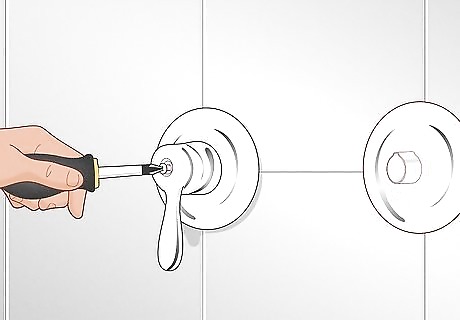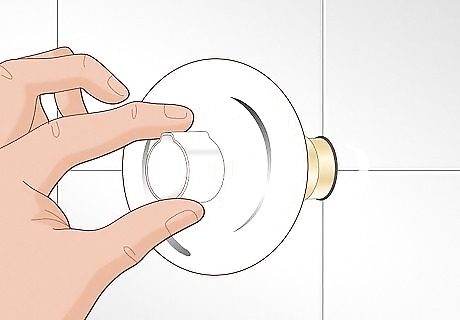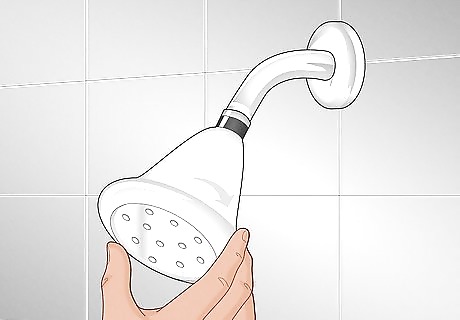
views
- Turn off the water supply and cover the floor with a canvas drop cloth before installing a new shower faucet.
- Remove the old faucet’s handles, spout, flange, and valve assemblies. Mark where the new heads will go and make cuts if necessary.
- Check and tape valves before installation, then install the new valve, followed by the sleeve, flange, and screw covers; use caulk to seal any gaps.
Preparing for the Job

Visit a bathroom showroom to pick out your new faucet. If you’re replacing an existing faucet, choose the same style of faucet already in place to make installation easiest. If not, remove the old parts and take them to your local hardware store to accurately match the new components. Many shower components come in pre-packaged sets, so you’ll have everything you need. There are 3 styles of shower faucets available: Single-handled shower faucets have a tee connection to both hot and cold water supplies and control water temperature and water flow with just 1 handle. Double-handled shower faucets have 1 control for hot water and 1 control for cold water. Three-handled shower faucets work the same as the double-handled faucets but have an additional handle for the bathtub. In this application, the third handle controls the strength of the water flow and determines whether the water goes to the tub or the shower.

Turn off your main water supply. Locate the shut-off valve for the appropriate bathroom and turn the water off. Most homes have shut-offs for individual bathrooms and one for the kitchen, so you should not need to shut off the water supply for the whole house. Once you have shut off the water supply, open the shower faucet valves to release any remaining water from the pipes to ensure the water is off. If you are on a city water system, the shut-off valve should be located at the water meter near the curb of your home or in your apartment building’s basement. If your home is on a private well, locate your water pressure tank in the basement or utility areas closest to where the water piping enters the building. Newer tanks are usually blue, while older tanks may be any color. Typically, the shut-off valve is on the main outlet pipe near the tank. To close this valve at either source, turn it clockwise until closed. This will immediately stop water flow to the house.

Cover the tub and/or the shower floor with a canvas drop cloth. Protect the tub with a cloth if cutting through tiles or the wall. Ensure the shower area is clean and dry, then use a painter’s drop cloth or other protective covering on the shower floor and tub surface to protect it from scratches and chips.
Removing the Old Components

Remove the handles with a screwdriver. Use a flat-headed screwdriver to pry up the small caps on each handle that control the water’s flow and temperature. These caps are usually marked with a “C” or “H” for cold or hot water. Under the cap will be a screw to release the handles. Remove the retaining screws then remove the handles by pulling them off the valve stems. If the screws are rusted, it may take a little extra effort to loosen the screws. If necessary, use penetrating oil to help break through the rust. If your handles have no visible screws, try twisting the handle off by going counterclockwise. After a few rotations, you’ll see the handle will be looser.

Twist the spout counterclockwise. The spout is the faucet part that delivers water to the tub. To remove the old spout, twist counterclockwise gently and pull towards you simultaneously. There may be a small screw that will require removal before you can take it off. You may find that pliers or a pipe wrench are helpful when removing old fixtures. On some faucets, the diverter handle will have an arrow on it. Use a flathead screwdriver, a butter knife, or something similar to pry the cap from the handle to reveal the retaining screw. Before removing the retaining screw, you'll need to open the valve completely by turning the handle counterclockwise. This keeps the valve from turning while removing the screw.

Firmly grasp the flange and twist counterclockwise. Chrome threaded flanges are about three inches long on most two-handle and three-handle faucets. As you twist the flange counterclockwise to remove it, you may see a white nylon threaded sleeve that may not come off. If this happens, simply grasp the sleeve with your hand or a pair of pliers and turn it counterclockwise to remove it. Single-handled faucets have a large round plate that is attached either with caulking or with screws. After removing the handle, remove the plate by removing the screws or by cutting the caulking with a utility knife. Then, pull the plate from the wall. Flanges offer a reliable, durable way to connect pipe systems, valves, and other plumbing components without welding.

Remove valve assemblies with an adjustable wrench. Valve assemblies should have a hex-shaped base near the wall. You can use an adjustable wrench or adjustable pliers to remove them. Turn them counterclockwise until they come loose. Once removed, use a damp cloth or an old toothbrush to remove debris from the threads of the water inlet pipes.

Mark where the new heads will go and make cuts if necessary. If you're installing a brand new faucet, you need to measure and mark the spots where you will install the new shower faucet and shower head. Drill holes using tile drill bits of the appropriate size of your shower components, and remove enough of the wall to access the pipe for proper installation. Shower faucets are typically installed at 45 to 48 inches (114.3 to 121.9 cm) with a shower head height of 72 to 78 inches (1.83 to 1.98 m). After making cuts, Clean the shower walls with a water and bleach mixture or white vinegar water. Do not mix bleach and vinegar, as it can release a noxious gas. Do not allow water to drip behind the wall. If it does, dry thoroughly before installing the new fixtures.
Installing New Valves

Open and check the valve assemblies before installation. To open and check your valve assemblies, turn the stems counterclockwise. Each valve must be opened when installed to allow it to sit on the pipe components. Be sure to identify the diverter valve and set it aside to install it last. Installing a new faucet will be nearly the same as when you disassembled it. The only difference is you’ll perform the steps in reverse. Valves are arguably the most important part of your faucet system. They are designed to control water flow and temperature.

Tape the new valves with plumber’s tape. Peel the end of your plumber’s tape back a couple of inches. With the new valve in one hand, hold the threaded base pointing to your other hand. Place the loose end of the plumber’s tape over the threads and secure it with your thumb, then wrap tightly around the threads clockwise for three complete wraps. Pull tightly against the threads until the tape breaks. Roll the loose end over the taped threads. Done correctly, the tape will contour to the threads. Repeat this process for all the new valve components. Taping the valves creates a tighter seal, ensuring the faucet won't leak.

Slip the new valve onto the pipe and turn clockwise. You can use your fingers to accomplish this step. Twist it into place with three or four complete turns. There should be some resistance after that because of the plumber’s tape. If the valve does not sit in the threaded pipe within the first turn or two, start again. Do not force an improperly seated valve. It will strip the threads and cause a serious leak. Repeat this step for all valves. Completely tighten the valves with adjustable pliers or an adjustable wrench. Do not over-tighten, or you’ll risk damaging the valve or the water pipes.

Twist the sleeve onto the interior pipe with your hands. Slip the threaded white nylon sleeve onto each valve stem. Then, twist it into the threaded interior of the valve base. Do not use pliers or a pipe wrench, this will damage the threads. Wrap a cloth rag around the sleeve, grip it tightly with your hand, and twist it into place.

Press the flange snug against the wall. Then, place the new faucet handle over the notched tip of the valve stem. Hold the handle firmly and insert and tighten the retaining screw. Do not over-tighten to avoid stripping the threads. Turn the handle clockwise to close the valve and place the handle in the shut-off position. Repeat these steps for each of the valves.

Slip the retaining screw cover on each handle. Insert the covers so “H” is on the left side, “C” is on the right side, and the arrow on the diverter cap is pointing down.

Use bathtub caulk to seal any gaps where hardware meets the shower wall. Caulk the fixtures where they touch the walls using a silicon caulk and allow it to dry. In general, you shouldn't use a freshly caulked shower for at least 24 hours.

Turn the water supply back on and check for leaks. Turn on your water supply and check that everything works properly. When you test your shower faucets, do not be surprised by some initial water sputtering. The water pressure is simply forcing air out of the line. The sputtering should stop within a few seconds.

Screw your new showerhead into place. If you’re also replacing your showerhead, unscrew the old one and allow the water to run for a few seconds. This will help clear out any debris or sediment that may have built up. Use plumber’s tape around the threaded neck of the shower pipe to create a tight seal. Then, follow the instructions on your new showerhead’s packaging for installation. Generally, you’ll re-screw the new showerhead in place with your hands or an adjustable wrench. Be careful not to over-tighten. Once snug, you can run the water again and check for leaks!



















Comments
0 comment